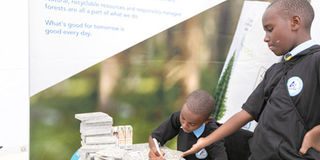Recycling waste into household and classroom products

Unknownst to many people, household waste such as food leftovers, plastic bottles and metallic items need to be disposed separately, each material with its own garbage bin. PHOTO | COURTESY
What you need to know:
Discarded wastes like plastic bottles, for instance, can block waterways leading to flooding.
- Household waste such as food leftovers, plastic bottles and metallic items need to be disposed separately, each material with its own garbage bin.
Poor disposal of used items or packaging materials can make our homes or schools’ environment filthy and unsafe to live in.
Discarded wastes like plastic bottles, for instance, can block waterways leading to flooding or become breeding grounds for bacteria and malaria spreading mosquitos.
But did you know that through recycling, a discarded milk or juice packet can be turned into a colourful dustbin or a classroom desk?
On a recent visit to the Hub mall in Karen, Nairobi, we met a group of Nairobi Primary School pupils who were on a campaign to create awareness on proper waste disposal.
WASTE DISPOSAL
Unbeknown to many people, household waste such as food leftovers, plastic bottles and metallic items need to be disposed separately, each material with its own garbage bin.
Master Julius Kibet Rotich, a Class Six pupil, says they choose to do the environmental awareness on a weekend because they were busy at school during the week as the rest of the world celebrated World Environment Day.
“We came to spread the word on environment pollution and waste disposal. If we dispose our wastes properly, then our environment will also remain clean,” Rotich said.
At the mall, dozens of products made of recycled tetra pak materials, from classroom desks to kitchen tables, garbage bins and ceiling boards were put on display for the public.
TETRA PAK RECYCLING
Tetra Paks are essentially made of paper and aluminium foil.
The colourful products had very attractive mosaic patterns since they had been made of Tetra Paks with different colours.
Judy Moraa, Rotich’s schoolmate, said while she wasn’t aware that tetra park trash can be turned into a desk, she was impressed by the innovation.
“I wouldn't mind studying on a recycled board or desk, they are just cool,” she said.
“We were taught in school that we’re not supposed to burn trash because the smoke pollutes the environment. So recycling is very important because it is environmentally safe,” said Moraa
Another pupil, Tracey Wanjiku, told JuniorSpot that they are encouraging the pupils to separate trash during disposal to make work easier for garbage collectors.
LAMINATED BOARDS
Mr Juma Busuru, a quality controller at Eko Tech Limited which specialises in recycling of Tetra Paks said that once the packets are brought in for recycling, they are shredded into tiny pieces.
They are then compressed under high temperature and pressure and cooled into large boards.
“We basically specialise in making laminated boards. These boards can however be used to make a wide range of items such as dustbins, ceiling boards or flooring titles,” Mr Busuru said. Adding that they began the recycling in 2006.
The firm started the initiative in 2006 because they noted that there was a need to start collecting tetra pack post-consumer waste and used packets. So they began engaging waste collectors, who now collect and sell to them used tetra packs.
In a month, during the dry season, they can recycle between 50 to 100 metric tonnes of tetra packs, but the activity slows down during the rain seasons because they get blotted which makes them hard to recycle.





